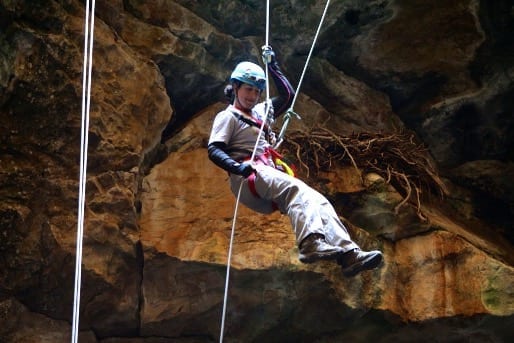When Rachael Lallensack, assistant editor of science and innovation for the Smithsonian Magazine, wrote in the February 2022 issue about “five fascinating finds” that provide glimpses into the Ice Age from Canada’s Yukon territory, at the top of her list was a near-perfectly preserved, 57,000-year-old wolf pup mummy, Canis lupus. Discovered by a gold miner in 2016, the female pup gave researchers a wealth of insights about her age, lifestyle and relationship to modern wolves.

Those researchers included Julie Meachen, Ph.D., associate professor of anatomy at DMU, who analyzed the wolf pup’s morphology.
The Ice Age pup was found on the ancestral land of the Tr’ondëk Hwëch’in people, who named her “Zhùr,” which means “wolf” in their Hän language. Lallensack called Zhùr “remarkable” because it’s the most complete wolf mummy known.
“She’s basically 100 percent intact – all that’s missing are her eyes,” says Dr. Meachen, who was first author of an article about Zhùr published in Current Biology in December 2020. “And the fact that she’s so complete allowed us to do so many lines of inquiry on her to basically reconstruct her life.”
She and other researchers, including scientists at the Yukon Beringia Interpretive Centre where Zhùr is displayed, believe the pup died at approximately seven weeks old when her den collapsed. Her quick burial protected her pristine remains from decomposing or being eaten by other Ice Age animals. Researchers also determined her fish-heavy diet was heavily influenced by how close she lived to water. In addition, her genetic signature is different from modern Yukon wolves, suggesting Zhùr’s population was eventually wiped out and replaced by another.
The Ice Age was the earth’s last glacial period that began about 100,000 years ago. As climate change continues to affect the planet, scientists expect more specimens like Zhùr to emerge from the permafrost.
“One small upside of climate change is that we’re going to find more of these mummies as permafrost melts,” Dr. Meachen says. “That’s a good way for science to reconstruct the Ice Age better, but it also shows us how much our planet is actually warming. We really need to be careful.”
Dr. Meachen also was honored last October by the Alf Museum in Claremont, CA, with its Raymond M. Alf Award for Excellence in Paleontological Research and Education for her efforts to mesh K-12 outreach with groundbreaking research into Natural Trap Cave in northern Wyoming.
“Dr. Meachen’s work has transformed our view of the ice age in North America,” Alf Museum Director Dr. Andrew Farke said when announcing the award at the museum’s 29th annual Peccary Dinner. He praised her for her work on fossilized mammals trapped in the 80-foot-deep sinkhole as well as for her work with high school students.

Dr. Meachen’s work focuses on how ice age mammals changed in response to shifts in climate and other natural factors. Her team also looks at impacts on microfauna, pollen and sediment. A publication on the effort is expected in an upcoming edition of Quaternary International.
Natural Trap Cave has been snagging animals for close to 50,000 years. Dr. Meachen focuses largely on animals trapped about 10,000 years ago. In addition to the advances in knowledge directly generated by her work, she emphasizes the significance of the outreach program with high school students.
“The importance this science education is particularly acute today with the global pandemic and the threat of climate change all around the globe,” she says. “These students get training that they wouldn’t normally get in a high school classroom, which makes them more scientifically literate.”

